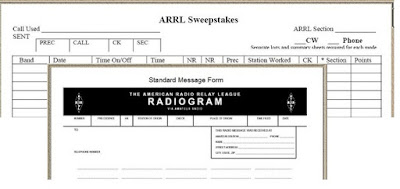- [x] 2018 CQ WW Cw Contest - Only 81 QSOs remotely, but at least a presence.
- [x] 2017 CQ WW Cw Contest - 727 QSOs & 260 multipliers - for winging it remotely.
- [x] 2016 CQ WW Cw Contest - 194-Q's/143-Mults remotely from the SF East Bay area.
- [x] 2015 CQ WW Cw Contest - 225-Q's/211-Mults run remotely from 2 hotels.
- [x] 2014 CQ WW Cw Contest - Multi-OP w/N6GEO (FLEX-3000 & KPA-500).
- [x] 2013 CQ WW Cw Contest - Joined-up w/NX6T crew for 3016-Q's & 651-Mults.
 |
| W M 6 Y & N 7 D A |
For WQ6X operations I chose to run another dual-OP operation from W7AYT's QTH enabling
opportunity to test-run various audio cable configurations between the Elecraft K3/0 (for NX6T
remote access), my FT-1000mp (in Concord) and laptop audio, used this weekend for streaming electronic music in the background (via Pandora) while running the radio contest.
Eventually, the messy junction-cabling will be replaced with a custom-configured switch box.
An advantage of combined audio is the ability to call CQ from NX6T in Fallbrook (using the K3/0) while monitoring that CQ call (on 80 & 40) using the FT-1000mp in the SF bay area.
For WQ6X CQ-WW operations the "antenna farm" @W7AYT was given a GooD workout.
The current antenna setup includes:
- The WQ6X Lazy 8JK Inverted Vee - recently converted from an 8JK Sloper.
- The WQ6X JA Sloper - which seems to favor an SA (not JA) directional pipeline.
- a Comet CHA-250 wide-band vertical - noisier but lower angle overall.
- a Hy-Gain 3-element 10-meter "Long John" yagi - tunes FB on 15-M to work SA.
8JK Vee and JA Sloper to run in parallel, taking advantage of the advantages of each antenna.
 At NX6T in Fallbrook (900' above sea level), tower #2 was raised to its full 72' height for maximum DX reach.
At NX6T in Fallbrook (900' above sea level), tower #2 was raised to its full 72' height for maximum DX reach.With Tower #1 a recent rotor malfunction was remedied, restoring the ability to "sweep" back and
forth while running a frequency. Working Africa from NX6T is not an easy thing to do; however thanks to yagi-sweeping we were able to "Zoom-in" on individual countries and amazingly, break pileups on 1st/2nd call.
In Fallbrook, both afternoons presented us with propagation to JA & SA simultaneously. When that happens I switch over to the 3-el Stepp-IR on tower 2, running it in BI-directional mode. During those periods the log is interleaved with SA/JA & S-E (USA/Caribbean stations). Eventually when SA stations had either faded or all been worked, the yagi was pointed 100% to JA. Unlike years past, the JA presence near the end
of the 2019 GiG was noticeably substantial.
In years past, we've had all but a skeleton crew on Sunday afternoon in the CQ W.W. contests.
This year we had 2 B-i-C OPs and N6KI running remotely, freeing me to work the bands as WQ6X from the bay area. While my 52-QSO total was hardly worth mentioning, the opportunity to test various antenna configurations & combinations was what the 2019 event was all about anyway;
in that respect it was a resounding success.
When it was all over NX6T ended up taking 1st place for San Diego, the 6th call
area and possibly even Zone 3; for USA & North America, we were 14th & 16th place.
Did YOU work the CQ WW Dx Cw contest?
Is NX6T and/or WQ6X in YOUR LoG?





















